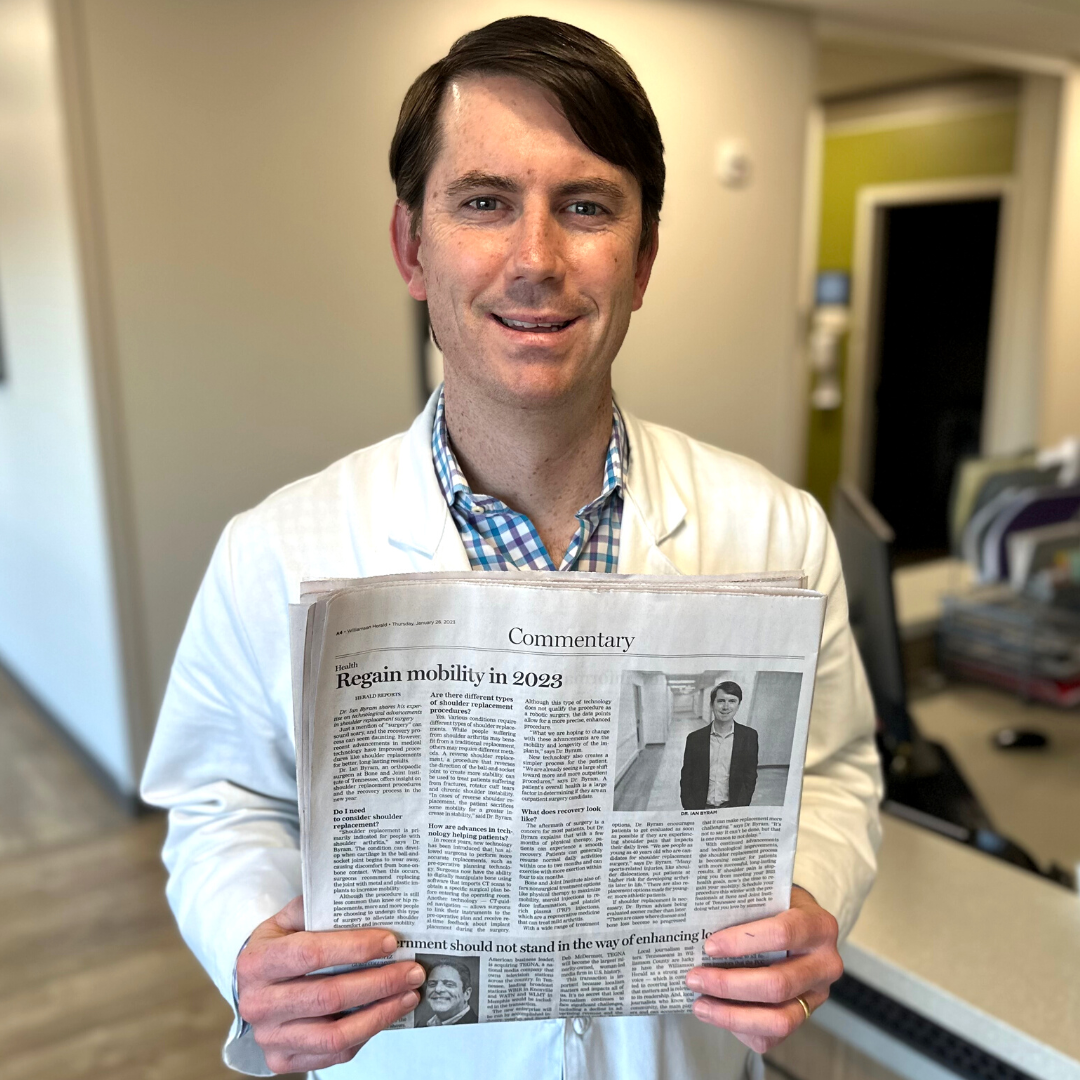
03 Feb Regaining Shoulder Mobility for Summer 2023 with Dr. Ian Byram
Originally published in the Williamson Herald –
Just a mention of “surgery” can sound scary, and the recovery process can seem daunting. However, recent advancements in medical technology have improved procedures like shoulder replacements for better, long-lasting results.
Dr. Ian Byram, an orthopaedic surgeon at Bone and Joint Institute of Tennessee, offers insight on shoulder replacement procedures and the recovery process in the new year.
Do I need to consider shoulder replacement?
“Shoulder replacement is primarily indicated for people with shoulder arthritis,” says Dr. Byram. The condition can develop when cartilage in the ball-and-socket joint begins to wear away, causing discomfort from bone-on-bone contact. When this occurs, surgeons recommend replacing the joint with metal and plastic implants to increase mobility.
Although the procedure is still less common than knee or hip replacements, more and more people are choosing to undergo this type of surgery to alleviate shoulder discomfort and increase mobility.
Are there different types of shoulder replacement procedures?
Yes. Various conditions require different types of shoulder replacements. While people suffering from shoulder arthritis may benefit from a traditional replacement, others may require different methods. A reverse shoulder replacement, a procedure that reverses the direction of the ball-and-socket joint to create more stability, can be used to treat patients suffering from fractures, rotator cuff tears and chronic shoulder instability. “In cases of reverse shoulder replacement, the patient sacrifices some mobility for a greater increase in stability,” says Dr. Byram.
How are advances in technology helping patients?
In recent years, new technology has been introduced that has allowed surgeons to perform more accurate replacements, such as pre-operative planning technology. Surgeons now have the ability to digitally manipulate bone using software that imports CT scans to obtain a specific surgical plan before entering the operating room. Another technology – CT-guided navigation – allows surgeons to link their instruments to the pre-operative plan and receive real-time feedback about implant placement during the surgery. Although this type of technology does not qualify the procedure as a robotic surgery, the data points allow for a more precise, enhanced procedure.
“What we are hoping to change with these advancements are the mobility and longevity of the implants,” says Dr. Byram.
New technology also creates a simpler process for the patient. “We are already seeing a large shift toward more and more outpatient procedures,” says Dr. Byram. A patient’s overall health is a large factor in determining if they are an outpatient surgery candidate.
What does recovery look like?
The aftermath of surgery is a concern for most patients, but Dr. Byram explains that with a few months of physical therapy, patients can experience a smooth recovery. Patients can generally resume normal daily activities within one to two months and can exercise with more exertion within four to six months.
Bone and Joint Institute also offers nonsurgical treatment options like physical therapy to maximize mobility, steroid injections to reduce inflammation, and platelet rich plasma (PRP) injections, which are a regenerative medicine that can treat mild arthritis.
With a wide range of treatment options, Dr. Byram encourages patients to get evaluated as soon as possible if they are experiencing shoulder pain that impacts their daily lives. “We see people as young as 40 years old who are candidates for shoulder replacement surgery,” says Dr. Byram. “Many sports-related injuries, like shoulder dislocations, put patients at higher risk for developing arthritis later in life.” There are also replacement options made for younger, more athletic patients.
If shoulder replacement is necessary, Dr. Byram advises being evaluated sooner rather than later. “There are cases where disease and bone loss become so progressed that it can make replacement more challenging,” says Dr. Byram. “It’s not to say it can’t be done, but that is one reason to not delay.”
With continued advancements and technological improvements, the shoulder replacement process is becoming easier for patients with more successful, long-lasting results. If shoulder pain is stopping you from meeting your 2023 health goals, now’s the time to regain your mobility. To setup your consultation today, click here or call the clinic at (615) 791-2630.
